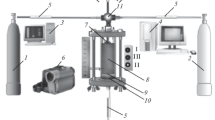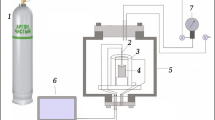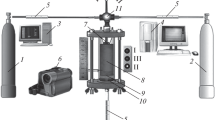Abstract
We have studied the combustion process and the phase composition of its products using granulated 70 wt % (Ti + C) + 30 wt % (3Cr + 2C) and 80 wt % (Ti + C) + 20 wt % (3Cr + 2C) mixtures with nickel-containing binders. The results demonstrate that the addition of a nickel binder reduces the chromium content of the (Ti,Cr)C double carbide, because nickel reacts with chromium to form Nichrome. In the case of combustion of the granulated 80 wt % (Ti + C) + 20 wt % (3Cr + 2C) mixture with the addition of Kh20N80 Nichrome, a Nichrome-binder-containing (Ti,Cr)C double carbide essentially free of impurity phases according to X-ray diffraction data has been prepared in a single step. A two-step mechanism of final product formation has been proposed. According to scanning electron microscopy data, the grain size of the combustion products is 2–5 μm, which is an order of magnitude smaller than the initial titanium and chromium particle size. In contrast to powder mixture combustion products, which are difficult to disintegrate, the agglomerate obtained via the combustion of a granulated mixture broke into separate granules, which could be ground to a desired particle size under laboratory conditions.








Similar content being viewed by others
Notes
Samples for analysis were provided by V.V. Zakorzhevski.
REFERENCES
Komratov, G.N., Kinetics of oxidation SHS of titanium carbide and titanium and chromium double carbide powders in air, Powder Metall. Met. Ceram., 1993, vol. 32, no. 6, pp. 509–511. https://doi.org/10.1007/BF00560730
Borisov, Yu.S., Borisova, A.L., Kolomytsev, M.V., Masyuchok, O.P., Timofeeva, I.I., and Vasilkovskaya, M.A., Protective and functional powder coatings high-velocity air plasma spraying of (Ti, Cr)C–32 wt. % Ni clad powder, Powder Metall. Met. Ceram., 2017, vol. 56, nos. 5–6, pp. 305–315. https://doi.org/10.1007/s11106-017-9898-0
Varma, A. and Mukasyan, A.S., Combustion synthesis of advanced materials: fundamentals and applications, Korean J. Chem. Eng., 2004, vol. 21, no. 2, pp. 527–536.
Kurbatkina, V.V., Patsera, E.I., and Levashov, E.A., Preparation of ultrarefractory carbides by self-propagating high-temperature synthesis, in Tekhnologicheskoe gorenie (Technological Combustion), Moscow, 2018, p. 247. https://doi.org/10.31857/S9785907036383000025
Rogachev, A.S. and Mukasyan, A.S., Gorenie dlya sinteza materialov (Materials Synthesis via Combustion), Moscow: Fizmatlit, 2012.
Zhang, W.N., Wang, H.Y., Wang, P.J., Zhang, J., He, L., and Jiang, Q.C., Effect of Cr content on the SHS reaction of Cr–Ti–C system, J. Alloys Compd., 2008, vol. 465, pp. 127–131. https://doi.org/10.1016/j.jallcom.2007.10.092
Zhang, W.N., Wang, H.Y., Yin, S.Q., and Jiang, Q.C., Effect of Ti/C ratio on the SHS reaction of Cr–Ti–C system, Mater. Lett., 2007, vol. 61, pp. 3075–3078. https://doi.org/10.1016/j.matlet.2006.11.003
Vlasov, V.A., Sharivker, S.Yu., Ponomarev, V.I., Khomenko, N.Yu., Belikova, A.F., and Zakorzhevski, V.V., Annealing of Ti–Cr carbide produced by SHS, Int. J. Self.-Propag. High-Temp. Synth., 1997, vol. 6, no. 4, pp. 431–437.
Seplyarskii, B.S., Kochetkov, R.A., Lisina, T.G., Abzalov, N.I., and Alymov, M.A., Phase composition and structure of titanium carbide/nickel binder synthesis products, Inorg. Mater., 2019, vol. 55, no. 11, pp. 1104-1110. https://doi.org/10.1134/S0020168519110116
Seplyarskii, B.S. and Kochetkov, R.A., Granulation as a tool for stabilization of SHS reactions, Int. J. Self.-Propag. High-Temp. Synth., 2017, vol. 26, no. 2, pp. 134–136. https://doi.org/10.3103/S106138621702011X
Turchia, P.E.A., Kaufmanb, L., and Liuc Zi-Kui, Modeling of Ni–Cr–Mo based alloys: Part I-.-.-phase stability, Comput. Coupling Phase Diagrams Thermochem., 2006, vol. 30, pp. 70–87. https://doi.org/10.1016/j.calphad.2005.10.003
Author information
Authors and Affiliations
Corresponding author
Rights and permissions
About this article
Cite this article
Seplyarskii, B.S., Kochetkov, R.A., Abzalov, N.I. et al. Influence of Granulation and Ni-Containing Binder Composition on the Self-Propagating High-Temperature Synthesis of Carbides in the Ti–Cr–C System. Inorg Mater 56, 909–917 (2020). https://doi.org/10.1134/S0020168520080142
Received:
Revised:
Accepted:
Published:
Issue Date:
DOI: https://doi.org/10.1134/S0020168520080142




